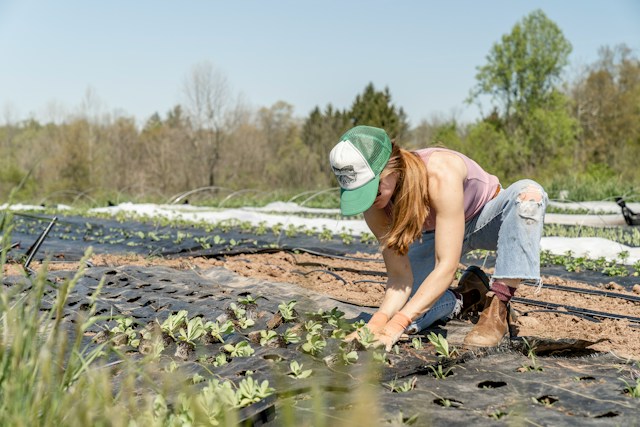Healthy soil is undoubtedly the cornerstone of agricultural productivity and sustainability.
It provides the structure, nutrients, and conducive environment necessary for vigorous plant growth.
For years, farmers and agricultural specialists have employed various practices aimed at enriching the earth’s crust to optimize crop yield.
One such approach is the strategic use of cover crops.
Despite being regarded as old farming wisdom, it remains an instrumental technique in modern sustainable agriculture.
Unveiling its potential promises healthier soils, stronger yields, and ecologically balanced farming systems.
Contents
- Cover Crop Strategies For Healthier Produce Soil
- 1. Plant Nitrogen-Fixing Cover Crops Annually
- 2. Use organic mulch for soil fertility
- 3. Incorporate Diverse Species in Your Crop Rotation
- 4. Implement regular compost applications for nutrients
- 5. Allow for Sufficient Fallow Periods
- 6. Involve Livestock for Manure-Based Fertilization
- 7. Promote Natural Pest Control with Appropriate Crops
- The Bottom Line
Cover Crop Strategies For Healthier Produce Soil
1. Plant Nitrogen-Fixing Cover Crops Annually
One of the most effective ways to enhance soil fertility and maintain a healthy yield of produce is to plant nitrogen-fixing cover crops annually.
This strategy not only replenishes the soil but also supports the production of sustainable, healthy crops.
Planting nitrogen-fixing cover crops is a method that supports sustainable agriculture by aiding soil fertility and structure, reducing likelihood of erosion, and combating weeds naturally.
Nitrogen fixation refers to the process of plants taking nitrogen from the air and converting it into a form that plants can use to grow.
Among the main plants that do this job perfectly well are legumes, such as peas, beans, lentils, and certain species of flower such as clover.
These plants have a symbiotic relationship with bacteria in the soil that allows them to convert atmospheric nitrogen into nitrates, the form of nitrogen most usable to other plants.
When these cover crops are turned into the soil, they decompose therefore releasing the nitrogen they were storing, providing it to other crops.
This approach plays a crucial role in enriching the soil structure, thus enhancing the growth and productivity of subsequent crops.
Regularly planting nitrogen-fixing cover crops reduces the need for chemical fertilizers, thus lowering costs and reducing environmental harm.
Moreover, these crops improve soil structure, increase organic matter, and promote healthy soil biology.
Their deep root systems also help to prevent soil erosion during the offseason, making them very practical.
Nitrogen-fixing cover crops can be planted so they cover the ground throughout the year, thus never leaving the soil exposed.
Overall, integrating the practice of planting nitrogen-fixing cover crops annually creates a cycle of fertility that is self-supporting and sustainable.
It is essential for farmers to understand the species suitable for their specific soil type and geographical location in order to achieve the best results from the utilization of nitrogen-fixing cover crops.
With this approach, farmers can consistently build soil fertility year after year, thus ensuring a healthy, productive soil for growing produce.
Therefore, by embracing nitrogen-fixing cover crops in your farming system, you are not only nourishing your soil but also contributing to a greener and healthier environment.
2. Use organic mulch for soil fertility
Maintaining soil health is one of the critical components of successful sustainable farming and using organic mulch for soil fertility is a key strategy.
Farmers and gardeners utilize organic mulches as a way to enhance soil structure and fertility.
Organic mulches are derived from various sources such as hay, leaves, straw, wood chips, and grass clippings, these are readily available and offer multiple benefits.
Using organic mulch not only boosts soil fertility but also helps in conserving soil moisture, suppressing weed growth, and serving as a habitat for beneficial insects.
These mulches slowly decompose and add valuable nutrients back to the soil, enriching it and improving its ability to support plant growth.
It plays a vital role in supporting soil microbial communities, which are extremely valuable for the availability of nutrients and assistance in plant disease suppression.
Moreover, mulch acts as an insulation layer, protecting the soil from direct sun exposure and helping to keep the soil’s temperature more consistent.
Part of the strategy implemented in cover crop systems is the application of organic mulch after the cover crops are mowed or tilled into the soil.
The mulch helps to kickstart the decomposition process, adding nutrients back into the soil, giving the plants access to vital nutrients just when they need them.
Another key benefit of organic mulch is its ability to improve soil aeration and drainage.
By layering mulch onto the soil, it helps break compacted soil, allowing water to penetrate more deeply and air to circulate, which is crucial for root growth.
Lastly, organic mulch plays a significant role in soil erosion control.
Applying a layer of mulch helps protect the soil from being washed away by heavy rains, thus preserving valuable topsoil and keeping nutrients in place.
Despite the many benefits, it’s important to apply mulch properly, as improper application can sometimes lead to problems such as pests infestation or creation of a barrier to moisture and air penetration.
Overall, the use of organic mulch in cover crop strategies is a natural and beneficial means of maintaining and enhancing soil fertility.
3. Incorporate Diverse Species in Your Crop Rotation
One fundamental step towards healthier produce soil is incorporating diverse species in your crop rotation.
This strategy is important to break pest and disease cycles, and also boosts soil fertility by enhancing the microbial activity.
The practice of mono-cropping depletes soil of specific nutrients, but mingling through crop rotation helps stabilize the soil structure and controls soil degradation.
Rotating crops of varying root depths can significantly improve soil health by allowing nutrients and organic matter to be distributed throughout the soil profile.
When you diversify crop species, you effectively invite a diversity of soil organisms to thrive in your soil.
These organisms have different requirements and collectively they contribute to the natural ecological balance of the soil.
Moreover, diverse crop rotation encourages beneficial insects and natural predators to help control pests.
Leguminous plants such as clover, vetch, or lentils, should be included in rotation as they fix atmospheric nitrogen into the soil, promoting natural fertility.
Incorporating deep-rooting plants like daikon radish or alfalfa in rotation can improve water infiltration and break hardpan.
The crops chosen for rotation should be compatible with your produce’s growth requirements and market demand.
This not only promotes soil health but can also increase yield and profitability for farmers.
It is essential that the rotation plan be flexible, depending on the season, soil condition, and disease outbreak; this flexibility ensures resilience in the face of unpredictable weather or pest patterns.
Incorporating diverse species in your crop rotation might require more planning and coordination, but the long-term benefits far outweigh the initial efforts.
Healthy soil is undoubtedly the cornerstone for sustainable agriculture and is vital for producing nutrient-dense food.
By implementing proper crop rotation, farmers can enhance the soil’s structure, fertility, and resilience, leading to better produce and a more sustainable farming practice.
4. Implement regular compost applications for nutrients
Proper soil management is a cyclic process and implementing regular compost applications ensures constant replenishment of nutrients in your soil.
Different types of compost material contribute different types of nutrients, making compost a source of compounded nutritional value.
Compost is rich in macro and micronutrients that are essential for plant growth such as nitrogen, phosphorus and potassium.
In addition to enriching the soil, compost improves the soil structure, enhancing its ability to hold water and allowing roots to permeate through.
Compost has a positive impact on the soil’s pH, which affects the availability of most nutrients for crops uptake.
Some compost contain beneficial microorganisms that help in suppressing soil-borne diseases, thus improve crop health.
Regular compost applications not only supply nutrients but also improve the soil’s fertility over time.
Compost can be sourced from leftover organic kitchen waste, garden waste, animal manures, and agricultural residues, making it an inexpensive and sustainable soil fertility option.
Turning your compost pile regularly will speed up the process of decomposition and make the nutrients available faster.
The right time to apply compost is when preparing the planting beds at the onset of a new growing season.
Make sure to dig the compost into the ground so it can get to the roots of the plants where it is most needed.
Compost should be applied at rates suitable to the types of crops to ensure they are getting the appropriate nutrient content.
Composting is an eco-friendly solution that reduces waste going to the landfill.
Using compost on your fields is a way to practice sustainable agriculture, increasing crop yield without damaging the environment.
Regular compost applications are a key strategy in building and maintaining healthy productive soils in your farm or garden.
5. Allow for Sufficient Fallow Periods
The period when you let your land rest or lay fallow is an essential part of maintaining farm soil health.
In traditional agricultural practices, farmers give their land a break to naturally rejuvenate through the idea of fallow periods.
Fallow periods help the soil regain its nutrients that might have been lost during the cultivation of crops.
It also allows the soil to enhance its mineral and nitrogen content.
Fallow periods not only reduce soil erosion but also suppress weeds and pests, thereby promoting a healthier soil environment.
Though, the length of the fallow period depends on several factors including, the type of soil, the previous crop cultivated, and the local climate.
Typically, a fallow period lasts from a few months to a year, yet extending it up to two to three years could yield more significant benefits.
Allowing the land to lay fallow helps in the breakdown of crop residues and other organic material, adding essential nutrients to the soil.
During fallow periods, the microbial activity in the soil increases, resulting in improved soil texture and fertility.
This strategy, indeed, aligns well with the annual planting of nitrogen-fixing cover crops and the application of organic mulches and composts.
The fallow period intersects directly with the growth period of the cover crop, thereby enhancing the fertility of the soil through natural means.
Following the fallow period, cover crops can be planted to protect the soil from erosion and to replenish the nitrogen level.
Soil of the farm will then be well-fertilized, well-balanced, and ready for the next produce crop, leading to robust, healthier produce.
In the case of pest-control, allowing for a sufficient fallow period can help disrupt the lifecycle of numerous pests and diseases.
Thus, introducing a period of fallow in the cover cropping strategy can do wonders to make the soil more productive and healthy for future cropping.
6. Involve Livestock for Manure-Based Fertilization
Animal manure provides valuable organic matter and nutrients to the soil, enhancing its fertility over time.
Healthy soil is the foundation of a vibrant garden or farm, thus regular manure-based fertilization plays an instrumental role in soil maintenance.
This approach, on the other hand, serves as an efficient recycling system, transforming livestock wastes into beneficial agricultural inputs.
Integrating livestock into the crop rotation system amplifies the benefits of soil fertility.
Depending on the type of animal, the nutrient content of manure varies, offering a diverse range of nutrients to the soil.
For instance, poultry manure is high in nitrogen, ideal for plants needing a nitrogen boost, while cow and horse manure are effective for enhancing overall soil structure.
The process of manure decomposition slowly releases nutrients into the soil, ensuring a steady supply for plants and reducing the likelihood of nutrient leaching.
Moreover, manure reduces soil erosion and run-off by improving the soil’s ability to absorb and hold water.
Applying manure correctly is crucial for effective fertilization; this involves considering factors like its moisture content, type, and methods of application.
For example, fresh manure is a hot amendment that can burn plants if not adequately composted before application.
Manure can also be used in conjunction with other soil improvement methods like mulching, cover cropping, and composting.
It is equally important to be responsible for manure management to prevent over-fertilization and mitigate potential environmental impacts.
Proper timing of application is crucial, ideally applied to soil a few months before planting to allow sufficient time for nutrient breakdown.
Manure application should also be concentrated around the root zone of plants for maximum nutrient uptake.
Moreover, involving livestock in crop production systems can lead to a more resilient and self-sustaining farm, interconnected in a cycle of nutrient replenishment.
Therefore, manure-based fertilization is not merely a soil enrichment strategy, but a broader approach towards a sustainable and regenerative agriculture system.
7. Promote Natural Pest Control with Appropriate Crops
Pests can greatly diminish the quality and yield of your produce.
However, it’s essential to tread carefully when it comes to pest control, as many common methods can harm your soil and the beneficial organisms within it.
Instead of resorting to artificial pesticides, consider promoting natural pest control with the strategic planting of certain crops.
It’s a strategy that not only minimizes pest populations, but also contributes to healthier soil.
Many crops have pest-resistant characteristics and can dissuade pests naturally without the need for chemical intervention.
For instance, marigolds are known to deter various insects, including nematodes and aphids, through their strong scent.
Similarly, crops such as garlic and onions can repel pests with their pungent aromas.
On the other hand, there are crops like nasturtium and mustard that attract pests away from your main plants.
These ‘trap crops’ keep your produce safe while the pests feast on them instead. They are essentially sacrificial plants, serving to protect your main crops.
Choosing the right crops based on the pests in your area can be a powerful tool in natural pest management.
As an added benefit, these plants can also play a role in nitrogen fixation, contributing to soil fertility.
By planting a diverse array of these useful crops, you can nurture a balanced and healthy ecosystem in your farmland. This practice not just controls pests but also enriches the soil naturally.
So, while managing pests in your farm, remember to adopt a holistic approach that not only addresses the pest problem but also promotes soil health and sustainability.
This ensures the long-term productivity and viability of your farmland, leading to better quality and yield of your produce.
The Bottom Line
Optimal soil health and fertility is key to the sustainability and productivity of agriculture.
Incorporating these ideas into your farming practice can greatly enhance crop yield and health.
Planting nitrogen-fixing cover crops annually, using organic mulch, and implementing diverse crop rotations not only improves soil fertility but also helps protect against pests and diseases.
Regularly applying compost can replenish the soil with vital nutrients, while allowing for sufficient fallow periods gives the soil time to regenerate naturally.
Integrating livestock into the system contributes to manure-based fertilization, offering an eco-friendly alternative to synthetic fertilizers.
And lastly, promoting natural pest control methods can reduce dependency on chemical pesticides, contributing to an overall healthier environment.
Applying these strategies can help achieve a more sustainable and productive farming system.




